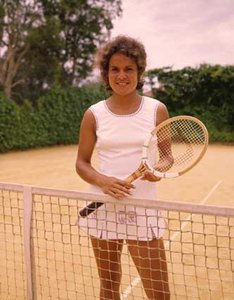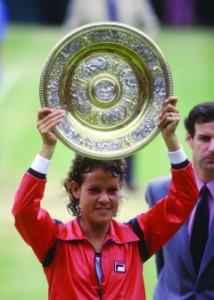Queens of the Court: Evonne Goolagong, A Luminous Star
Evonne Goolagong can be described in mathematical terms.
Parallels and angles. Circles and singularities (a situation that is completely unique). Chaos versus The Metronome.
She will be forever remembered as a seven-time Grand Slam winner: four Australian Open, two Wimbledon, and one French Open title(s).
She was a contemporary of Jimmy Connors. (Jimbo was born Sept. 2, 1952, Evonne on July 31, 1951), and her career paralleled his in its dramatic jump-start.
In 1970, at age 18, Connors recorded his first significant victory in the first round of the Pacific Southwest Open in Los Angeles, defeating Australian tennis legend Roy Emerson.
Goolagong came out of nowhere to win the 1971 French Open at the age of 19 and then shocked the world again a month later when she routed her idol, fellow Australian Margaret Court, 6-4, 6-1, to win her first Wimbledon title.
1971 was the year that Love Story was No. 1 at the box office (in the US at least) and “Joy to the World,” by Three Dog Night was the No. 1 song. It was also the year that the Pentagon Papers were leaked to the New York Times and Apollo 14 landed on the moon.
1968, three years before, was a seminal year in the annals of tennis. It was the moment (March 30) that saw the birth of the “open” era, where professionals were allowed to compete in the majors—the beginning of modern tennis.
In the early 1970s, big names at the top of the world of tennis included (as a friend recently wrote to me) Arthur Ashe and Rod Laver—Chris Evert and Evonne Goolagong too.

Goolagong was one of eight children from an Australian Aboriginal family.
I remember 1968 very clearly. I remember Arthur Ashe and Muhammad Ali, two diametrically opposed personalities; the former being the first African-American man to win a major in tennis (at the US Open), and the latter being stripped of his heavyweight title in April of that year.
In another article in our Queens of the Court series, I noted that almost no tennis players came from poverty. I wrote of the success of Althea Gibson
, being the first person of African descent, of any nationality, to win a major (1956) in the sport of tennis.
If Evonne Goolagong’s career sometimes paralleled that of Jimmy Connors, her life paralleled that of Althea Gibson.
Evonne was one of eight children from an Australian Aboriginal family, being a member of the Wiradjuri people, making her completely unique in the world of tennis. When she was a girl, her father, an itinerant sheep shearer, used to fashion makeshift tennis “paddles” for her out of pieces of wood.
Like Gibson, she was a consummate athlete. She played rugby, cricket, and soccer as a child, and at 13 left home to pursue the dream of a career in tennis.
Her game paralleled that of John McEnroe in that she was a volleyer who relied more on skill and speed than strength, and thus was vulnerable to opponents with a power game, big serves, and punching groundstrokes, such as that of Chris Evert and Billie Jean King.
Long-armed and graceful, with agile reflexes, Evonne Goolagong reputedly possessed the ability to cover the court with great precision. At her peak, like Johnny Mac, she was regarded as one of the most subtle practitioners the women’s game had ever seen.
Her greatest weakness, in a complete departure from Johnny Mac: lapses of concentration that may have cost her several titles, and for which her home press in Australia used to take her to task.
Her luminous and memorable rivalry with Evert, so fondly remembered by my friend, was dominated by Evert, who led 21-12; in the majors Evert’s edge was 3-2 (a ratio that roughly paralleled their overall record).

Goolagong won her first Wimbledon title as a teenager in 1971 and her second as a mother in 1980.
Evonne first met Evert in the 1972 Wimbledon semis, where Evonne pulled out with a third-set rally, 4-6, 6-3, 6-4. Goolagong won their initial championship encounter, the 1974 Australian, 7-6 (7-5), 4-6, 6-0.
Their tightly contested 1975 US Open contest was a three-setter that Goolagong lost 5–7, 6–4, 6–2, and their 1976 Wimbledon final also resulted in a three-set thriller that Goolagong lost 6–3, 4–6, 8–6.
She beat rising star Martina Navratilova for her second Australian Open title in 1975. After that, Evert and Navratilova would dominate the Ladies’ Tour for the latter half of the decade of the 1970s (though Goolagong was ranked World No. 1 in 1976).
In 1980, Goolagong became only the third mother in history to win Wimbledon (in a parallel with Kim Clijsters’ 2009 USO experience). She upset Tracy Austin in the semifinal and Evert in the final of the 1980 Wimbledon.
“When I was 19, I didn’t appreciate it,” she said comparing her two Wimbledon titles that, separated by nine years, book-ended her career. “But in ’80, I had a child and nobody expected much. That was amazingly sweet.”
Enjoy this five-minute clip of Evonne’s win against Austin in the 1980 Wimbledon semifinals.
Read other articles in this series about women and their contributions to the game. See how 19th-century American Molla Mallory pioneered the “look” of flowing short skirts for ladies’ tennis, and how Helen Willis came of age as an American rival of Suzanne Lenglen. Look for other articles about Billie Jean King (BJK), and Martina Navratilova among others.
- Evonne Goolagong
- Billie Jean King
- Maria Bueno
- Margaret Court
- Steffi Graf
- Chris Evert
- Martina Navratilova
- Monica Seles
Claudia Celestial Girl is a regular tennis contributor for Bleacher Report and has graciously allowed her work in the “Queens of the Court” series to appear on Sports Then and Now.










